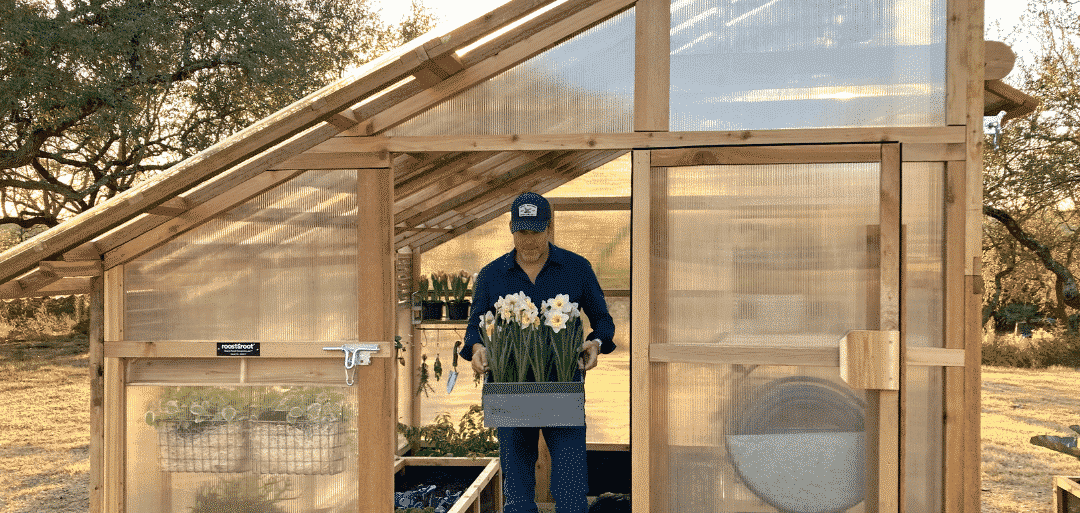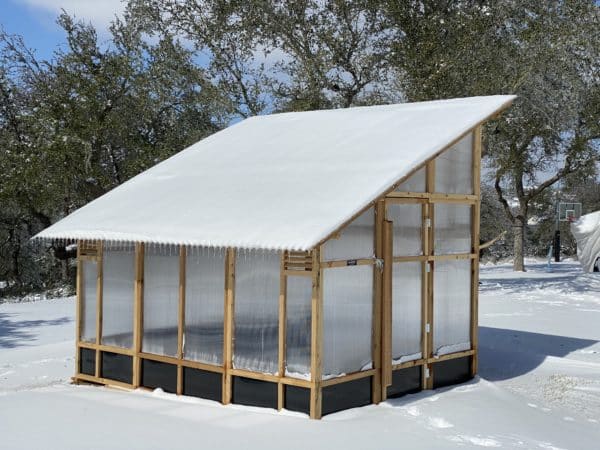
Fall is here and soon enough, depending on where you live, leaves will fall and temperatures will drop. As you begin to relocate plants inside your Fall greenhouse or even begin new seedlings, there are a number of tips that will help you transition smoothly into Fall and Winter. To help prepare you to make the most of the new season, we’ve compiled a list of handy tips to reference below.
Fall/Winter with the Slant-Roof Greenhouse™
Before we jump into our guided tips, let’s first share a bit more about how our greenhouse fares in the cooler seasons. Built with Polycarbonate, the panels of the greenhouse do not get brittle in the cold. Period. The greenhouse will heat up during the daytime from sunlight. May rise 40 degrees F or more than the outside temperature. At night, it will hold some of the heat from the daytime, but cool off considerably because of no sun. At all times, the greenhouse protects from wind chill.
When it comes to snow load, the 25° pitch roof should in many circumstances shed snow on its own, especially if the interior warms up significantly during the day or supplemental heat is used to avoid freezing. If significant amounts of snow accumulate, we would recommend periodically knocking it off. The back edge of the roof is extended enough that we expect the snow that slides off to not pack against the back wall. We load tested the roof with #800 lbs of sandbags equally distributed and it deflected an acceptable amount. Solar panel snow accumulation should be monitored and safely removed periodically as well.

Heating Systems:
Depending on your location and crops, a heater will not only help deter frost from your growing plants but make for a comfortable time as you tend to your indoor crop. As with any use of heat conductive devices, it’s important to select a heater that will limit fire risk. To help shop for the ideal heater, we’ve collected a buyer’s guide to help below.
Types of heaters to use?
With a square footage of less than 100 sq. ft, heating the Slant-Roof Greenhouse™ doesn’t require much wattage to warm the space. When selecting a greenhouse heater, we suggest steering away from gas heating to prevent any risk. Heaters with tip-over and over-heating shut-off functions are ideal to reduce concern.
When narrowing down heater options, it is best to avoid infrared space heaters as they often aim to heat up objects and not entire spaces. Ideally, heaters with fans will prevent overheating any specific area too much. If you experience fluctuating cold temperatures through Fall & Winter, you may prefer heaters that have a thermostatic control to adjust heat accordingly while limiting energy use.
What to Continue Or Start Growing:
What you choose to grow within your greenhouse during the Fall & Winter greatly depends on the plant’s hardiness, daily temperatures, and whether or not your greenhouse will be heated. Fall/Winter favorites include a number of hardy greens and root vegetables. Below are a few of our favorites, as with each, there are a number of varieties that perform differently. Based on your preference and location we recommend researching and selecting a variety that you’ll love.
Winter Root Vegetables:
Onions
Shallots
Garlic
Potatoes
Turnips
Hardy Greens:
Kale
Cabbage
Spinach
Broccoli
Brussel Sprouts
Watering:
Whereas Summer and Spring bring forth the possibility of underwatering, Fall and Winter bring forth accidental overwatering. With less sunlight after the Fall equinox, it becomes preferable to water in the middle of the day when it’s typically the warmest.
It’s important to note that many plants go dormant in the winter and will take longer to dry, requiring much less water. When choosing how much to water your plants, be careful not to soak your plants, especially when freezing temperatures are expected at night. It’s also best to be more cautious about your watering method, as wet leaves will easily lead to frost damage. Depending on what you are growing, we advise referring to your plant’s recommended watering needs and adjusting a watering schedule accordingly.
Nonelectric Heat Boosting Options:
Despite being unheated, your greenhouse will still greatly protect your growing veggies. However, there are additional care tips that will further ensure your plant’s protection in the harshest of winters.
Horticulture Fleece:
Depending on your nightly temperatures, you may choose to add horticulture fleece to provide extra warmth. Based on where you live, we recommend carefully selecting a fleece thickness that best suits your local temperatures.
Relocating Compost:
If you have an ongoing composter, moving it in your greenhouse is a natural way to not only encourage its continued breakdown but also heat your greenhouse naturally. A composter in your Winter/ Fall greenhouse will also help you enter the spring season with some great natural fertilizer to kick off the warm season.
Mulching:
Much like a blanket, applying mulch after the first hard freeze will help insulate your cold season crops. No more than 3 inches of mulch should protect your crop well into the cool season. A few types of organic mulch options may range from straw, fallen leaves, pine needles, or wood chips.
We hope you found these tips helpful for your backyard farming journey. Have questions or comments regarding anything mentioned in this blog post? Please feel free to email us at support@roostandroot.com or give us a call at 877-741-2667.


